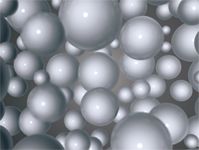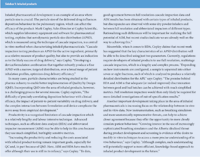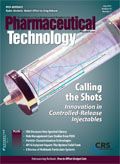The Power of Particle Characterization
Pharma's drive for manufacturing efficiency is bolstering particle-characterization technologies.
Particle-characterization data is central to the development, manufacture, and quality control of pharmaceutical products. The characteristics of a pharmaceutical's composite particles can affect the product in many ways, including by influencing drug efficacy and stability, as well as how the product behaves during processing. When considering the importance of particle characterization, the International Conference on Harmonization's (ICH) Q6A guideline on specifications (1) is a useful starting point because it identifies potentially important particle variables, including polymorphic form, enantiomeric purity, and particle size and distribution. The guideline also provides a decision tree to help determine when related testing is required.
Historically, industry has paid greater attention to control of particle size and distribution, which, according to ICH Q6A, can significantly affect the dissolution rates, bioavailability, and stability of drug substances in both solid and suspension products. Today, particle characteristics are attracting even greater focus as industry strives to increase manufacturing efficiencies. This drive has been largely influenced by the growing emphasis on quality by design (QbD), which encourages pharmaceutical companies to use an information- and risk-based approach to optimize product development and manufacture. Using particle characterization to understand how a product behaves during processing supports this initiative.

IMAGE: INFLUX PRODUCTIONS, PHOTODISK, GETTY IMAGES
This article takes a brief look at what factors have driven innovations in particle-characterization techniques and how technology may advance in this area in the coming years.
Innovations in particle characterization
Two of the earliest particle-sizing techniques were manual microscopy and sieving. These methods are still used today, but both have drawbacks. For instance, microscopy is slow and manually intensive, while sieving is unsuitable for fine or cohesive materials. As such, industry has sought more advanced particle-sizing techniques.
One such approach that is gaining popularity is laser diffraction. "Although laser diffraction methods have been used for the last 30 years, continuous development has resulted in much more accurate and reproducible measurements between manufacturers," explains Graham Rideal, founder of and a senior scientist at Whitehouse Scientific, which specializes in particle-sizing methods.
Paul Kippax, product group manager at Malvern Instruments, a producer of analytical equipment, agrees that laser diffraction is an important technology, particularly because its measurement range (0.1 to 3000 μ) covers the vast majority of particle-sizing applications used by industry. In addition, laser diffraction is capable of high-speed size distribution sampling (typically less than 20 s, according to Kippax), is nondestructive, and is suitable for automation. "Today's laboratory laser diffraction analyzers have been automated to the point of push-button operation, with sample loading being the only remaining routine manual task," says Kippax.
Imaging and microscopy are not being left behind, however. Some recent advances have been made with these analytical techniques. "The continuous and concomitant development of imaging technology and high-speed computers has transformed the humble microscope from a predominantly qualitative instrument into one of the most potent quantitative tools available today," explains Rideal. "This development has extended the definition of a particle from that of a simple equivalent spherical diameter into a comprehensive shape analysis where length, width, and perimeter can be measured at tremendous speeds."
Indeed, during the past few years, industry has placed a growing emphasis on particle characteristics other than size, such as shape, surface charge, and roughness. "Particle sizing is just one element of particle characterization," says Rideal. "Other disciplines in this sector include particle shape, flow properties, both in the dry state and as suspensions (rheology), morphology—including crystal structure, and porosity. Particle sizing alone is therefore not always the sole answer to efficacy.... A combination of physical properties is invariably investigated in arriving at the final solution."
According to Kippax, particle shape, in particular, has become an important parameter for both processing and final product quality. "In direct compression tableting, for example, shape is known to have an impact on blend uniformity, the consistency of powder flow through the press, compressibility, and the mechanical strength of the finished tablet," he says. "On the imaging front, many are also already looking beyond shape to composition."
Process development
Particle characterisation is used in many areas of the pharma industry, including excipient characterization and other quality control applications. Additionally, particle charcterization has a large role to play in the development of inhaled pharmaceuticals (see sidebar 1: Inhaled pharmaceuticals). The industry’s drive for improved manufacturing efficiencies has also increased the uptake of particle characterization technologies during process development. Particle characterization data help manufacturers to better understand their product, and provide the opportunity for process optimization according to the product’s characteristics. In isolation, however, particle characterization data do not always provide sufficient information to achieve this. In this case, techniques that characterize the powder, rather than the constituent particles, can play an important role. Over the past few years, there have been a number of advances in the area of powder characterization have helped manufacturers better understand their processes, ultimately leading to more efficient manufacturing (see sidebar 2: Powder characterisation).

Sidebar 1: Inhaled Pharmaceuticals
Understanding particle characteristics can benefit process development in several ways. The latest technologies, such as the on-line laser-diffraction systems noted above, enable processes to be monitored in real time during development work, which provides better control and facilitates scale up. "The sector's interest in on-line, real-time measurement has risen sharply as it works toward greater manufacturing efficiency," says Kippax. "Real-time monitoring accelerates the reliable identification of 'cause and effect' during process development and has a valuable role to play in the transition to smarter operation."

Sidebar 2: Powder Characterization
Real-time monitoring, however, is not yet available in all areas of particle characterization. Tim Freeman, director of operations at Freeman Technology, which specializes in powder characterization, adds, "I would perhaps highlight particle shape analysis—automated imaging—as a prime example of a technique with proven applicability, that would be a desirable addition to the real-time selection for pharma, but has yet to make this transition."
Another way that particle characterization can benefit process development is through simulation, which involves using characterization data to construct mathematical models that predict process performance. These models, if robust, can be used to conduct virtual experiments.
"The big attraction of process simulation is that it allows virtual experimentation, which is cheaper and quicker than the laboratory or pilot scale equivalent," explains Kippax. "The drawback is the effort required to develop a reliable model." Despite this, however, Kippax added that he expects process simulation to become more widely used within in the industry in the coming years because of the potential it has for aiding scale up and troubleshooting.
Future advances
Particle characterization has come a long way from its early days, but there is always room for more progress. "The next major development in particle sizing is likely to be in measuring in three dimensions," says Rideal. "Computer technology will be a driving force where the current impressive computer graphics from the film industry will be incorporated into particle sizing. There is also a move to borrow technology from the medical world, so expect to see X-ray CAT scans and MRI instruments appearing in the particle-metrology laboratory."
Meanwhile, Kippax is hopeful that there will be more advances in laser diffraction. "One goal is to make the performance gains already made more universally accessible. Greater embedded support during method development and throughout the measurement process, for example, would ensure that even inexperienced users could fully exploit the technology."
With such improvements on the horizon, industry's main challenge may not stem from technology, but rather from the skill of the operator using it. "Just because an instrument costs in excess of $100000 does not mean that the results are any better than using a sieve costing £100," says Rideal. "The old adage of 'rubbish in, rubbish out' has never been so relevant."
Reference
1. ICH, Q6A Specifications: Test Procedures and Acceptance Criteria for New Drug Products: Chemical Substances (May 2000).

Pharmaceutical Tariffs Are Imminent: How Industry is Bracing for Impact
April 16th 2025On April 14, 2025, the Trump Administration launched a national security-driven investigation into pharmaceuticals, a move that will likely result in tariffs being placed on pharmaceutical drugs, ingredients, and other components that are imported from outside of the United States.
Drug Solutions Podcast: A Closer Look at mRNA in Oncology and Vaccines
April 30th 2024In this episode fo the Drug Solutions Podcast, etherna’s vice-president of Technology and Innovation, Stefaan De Koker, discusses the merits and challenges of using mRNA as the foundation for therapeutics in oncology as well as for vaccines.